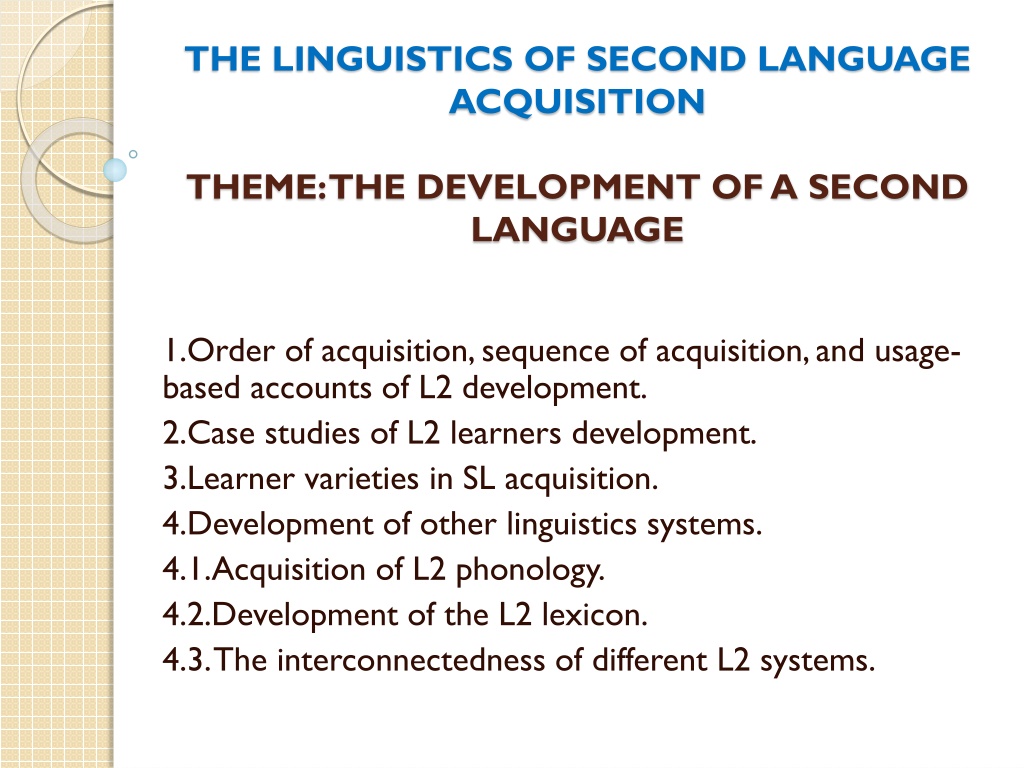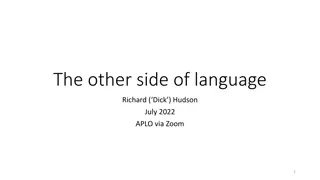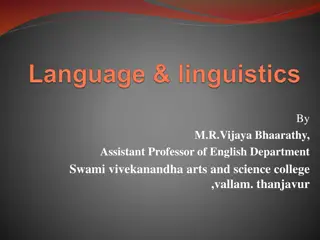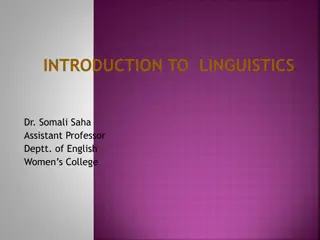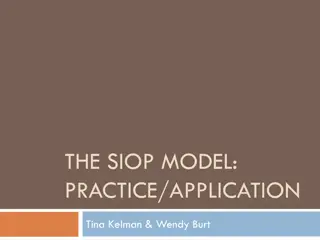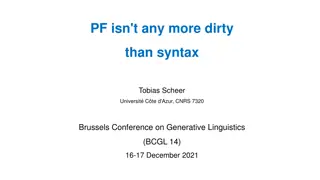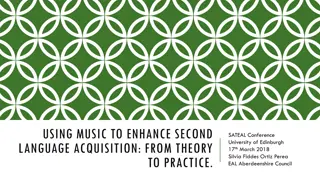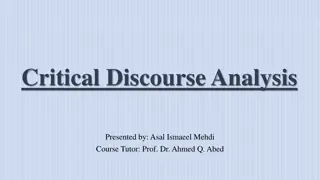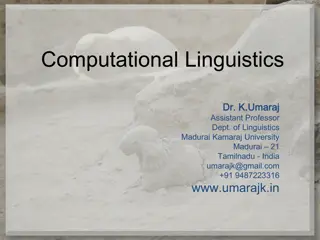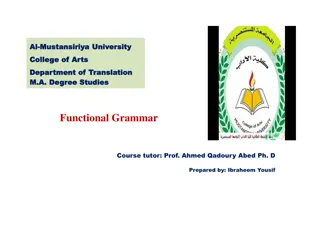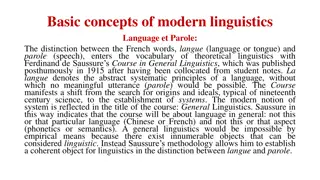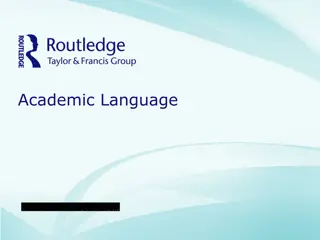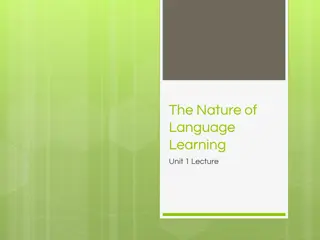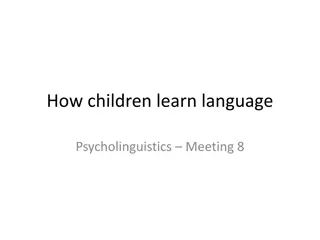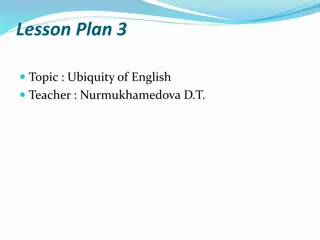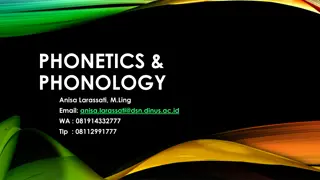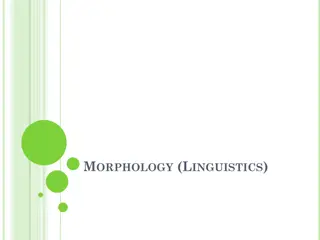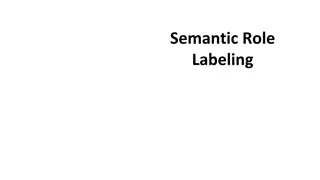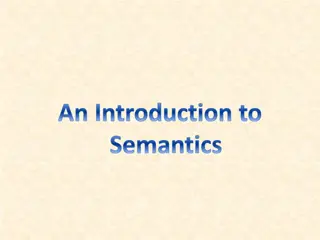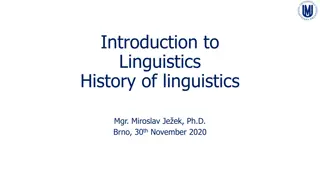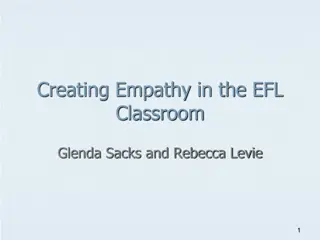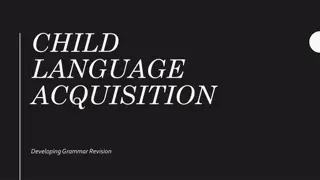Linguistics of Second Language Acquisition: Exploring Interlanguage Development
Explore the development of a second language through the lens of interlanguage, order of acquisition, and usage-based accounts. Delve into case studies, learner varieties, and the interconnectedness of different linguistic systems in SLA research.
Download Presentation

Please find below an Image/Link to download the presentation.
The content on the website is provided AS IS for your information and personal use only. It may not be sold, licensed, or shared on other websites without obtaining consent from the author. Download presentation by click this link. If you encounter any issues during the download, it is possible that the publisher has removed the file from their server.
E N D
Presentation Transcript
THE LINGUISTICS OF SECOND LANGUAGE ACQUISITION THEME: THE DEVELOPMENT OF A SECOND LANGUAGE 1.Order of acquisition, sequence of acquisition, and usage- based accounts of L2 development. 2.Case studies of L2 learners development. 3.Learner varieties in SL acquisition. 4.Development of other linguistics systems. 4.1.Acquisition of L2 phonology. 4.2.Development of the L2 lexicon. 4.3. The interconnectedness of different L2 systems.
Key terms interlanguage order of acquisition sequence of acquisition morpheme studies frequency analysis formulaic speech communicative competence learner variety in SLA
Interlanguage Interlanguage is the mental system of a second language that a learner constructs and that is different from the target language system. Interlanguage - system that a learner has constructed at a particular point of time or as a continuum. Research on interlanguage mainly focuses on grammar acquisition. Also: acquisition of pronunciation, vocabulary, and pragmatic features (for example, requests and apologies).
1. Order of acquisition, sequence of acquisition, and usage-based accounts of L2 development Interlanguage research: how does learners interlanguage modify over time? Order of acquisition - when learners achieve mastery of linguistic or pragmatic features. Mastery - learner s ability to produce specific grammatical forms accurately. 80% or 90% criterion level indicates mastery.
longitudinal studies ideal way to investigate order of acquisition. few cross-sectional studies (collect samples of learner language at just one time) determine the order of acquisition by equating it with the accuracy order. Not always valid Early studies (1970s) examined a set of English morphemes (e.g. verb + -ing, plural -s, articles, regular and irregular past tense). Later studies - grammatical systems, e.g. verb tenses.
The morpheme studies L2 morpheme studies used the methodology used to study how children acquire the grammar of their first language. Studies show L1 acquisition - clearly defined order of acquisition. Key finding: learners (children and adults) demonstrate a similar accuracy order. Dulay and Burt (1973, 1974) investigated Spanish and Chinese children learning L2 English. accuracy order for English morphemes was the same for both groups of learners.
Assumption: there is a natural order of acquisition which all learners followed??? order is not as fixed Evidence: Pica s (1983) study of naturalistic, instructed, and mixed learners of English found that although the accuracy orders in all 3 groups of learners were the same, there were differences among the groups in specific morphemes. The instructed group used plural -s more accurately than the naturalistic group, while the naturalistic group was more accurate than the instructed group in using verb + -ing Suggestion: linguistic environment had some influence on how and when these features were acquired. Both the learning environment and the learners first language influence the order of acquisition
Goldschneider and DeKeyser (2001) Examined 20 morpheme studies factor that explains the order of acquisition salience . learners first learn those morphemes whose meanings are transparent and discernible in the input.
Sequence of acquisition sequence of acquisition: syntactic and morphological features are acquired gradually, with learners passing through a number of stages of development. Development is determined not in terms of target-like accuracy, but in terms of whether there is evidence of the learner progressing from an early stage to a later one. frequency analysis: involves selecting a specific linguistic feature (e.g. negatives) and identifying occasions when learners use this feature and documenting the various linguistic devices they employ and how these change over time.
Usage-based accounts of learning Problems of frequency analysis. formulaic speech Early learner language is characterized by the use of formulaic sequences - I don t understand , I don t know . Chunks show the learner has reached a relatively late stage in the development of negation Learner has simply learned fixed lexical units! researchers only examine learners creative speech. Problem: unclear whether an utterance is a chunk or creatively constructed.
2.Case studies of L2 learners development Schmidt s (1983) study of Wes Wes was a 33-year-old Japanese learner of L2 English who left school at the age of fifteen and thus had had very little experience of formal instruction. He was a successful artist. He divided his time between living in Hawaii and Japan, spending increasing amounts of time in the former. He mixed predominantly with English speakers in Hawaii and thus experienced very little social distance from native speakers of English. Data were collected over a three year period mainly by means of one-hour tape-recorded monologues where Wes commented on his business, his daily activities, and his visits back to Japan. Schmidt also made recordings of informal conversations between Wes and native speakers.
Focus of Schmidts study: relationship between Wes s acculturation and his communicative competence. Components of communicative competence: (1) linguistic competence; (2) sociolinguistic competence; (3) discourse competence (4) strategic competence.
Findings of Schmidts study: Wes s linguistic competence remained limited. Pronunciation was good. Grammar hardly developed over the three-year period. Sociolinguistic competence developed: extensive use of formulaic expressions Discourse and strategic competence developed. Wes - effective communicator with low linguistic competence. No interdependence between acculturation and linguistic development .
R. Elliss (1984, 1992) study of two classroom learners Ellis R. investigated classroom rather than naturalistic L2 learners. There were three learners, all children aged ten to 13 years, and all complete beginners at the start of the study. They were learning English in a language centre in an outer suburb of London. The ten-year-old was Portuguese while the other two (a brother and sister) came from Pakistan. He collected data over a two-year period by sitting in their English classes and noting down all the utterances they produced together with contextual information relating to the function and audience of their utterances. He focused on their communicative speech rather than the language they produced in formal practice activities. His initial purpose in conducting these case studies was to examine whether the pattern of development evident in these classroom learners was the same as or different from the pattern reported for naturalistic learners. In other words, he wanted to know whether the instructional setting influenced the way in which the children learned English.
Focus of Elliss study formulaic sequences learners started modifying formulas with time and used language creatively. e.g. I don t know - I don t understand sequence of acquisition for negatives and interrogatives development similar to each other and very similarity to naturalistic learners!
Findings of Elliss study 1) learners relied initially on formulaic chunks and gradually learned how to manipulate them to produce novel utterances. 2) pattern of development was similar to naturalistic learners, so the classroom setting did not have a major effect on how learners linguistic competence developed. 3) after two years, their development of interrogatives and negatives was still limited.
Jia and Fuses (2007) study of Chinese ESL learners This was a five-year study that investigated the acquisition of a set of six English grammatical morphemes (regular and irregular past tense, third-person singular - s, verb + - ing, copula be, and auxiliary do). There were 10 learners in this study 5 girls and 5 boys who were aged between five and 16 years when they first arrived in the US. They all attended English-speaking schools where 70% of the students were native speakers of English. They all received focused ESL instruction for a period of time. Jia and Fuse divided the learners into 2 groups 6 who were early arrivals and 4 who were late arrivals. The main aims were to investigate the acquisition trajectories of these features and whether there were any age-related differences.
Methodology Instrument: story telling prompted by pictures and interviews about the learners activities in their schools and at home. Duration: 5 years. Occasions for 6 morphemes were identified and the percentage correct use calculated. Order of acquisition of morphemes was determined: by examining the number of learners who mastered each morpheme and by calculating the total percentage accuracy of each morpheme for all the learners.
Findings Age of arrival of learners - no effect on the order of acquisition. Easiest structures - progressive -ing and auxiliary do Most difficult - were regular past tense and third- person -s. Age-related effects: the early arrivals demonstrated greater accuracy than the late arrivals. The acquisition trajectories of the morphemes differed markedly: -ing and plural s showed accelerated learning initially and then levelled off. 3rdperson -s was acquired slowly regular past tense showed no significant growth over time. Explanation: word frequency and salience
Generalizations about L2 development 1. For some learners little grammatical development takes place (Wes). 2. L2 development is uneven: some grammatical features develop steadily, others develop rapidly at the beginning and then plateau. Structures follow different trajectories (pace of acquisition). 3. Grammatical development is not linear; fluctuations in the accuracy - backsliding. 4. Learners early attempts to use the L2 are characterized by structural and semantic simplification.
Generalizations (continued) 5. learners use formulaic expressions in the early stages. 6. grammatical morphemes acquired in a relatively fixed order irrespective of the age of learners. 7. evidence of sequences of acquisition for both naturalistic and classroom learners. 8. differences exist in the rate and success of acquisition by individual learners. Factors: learner s first language, age, richness of learning environment.
3.Learner varieties in SL acquisition learner variety is a coherent linguistic system produced by a language learner (Dimroth, 2012). a learner variety is an interlanguage. pre-basic variety - nominal utterance organization (i.e. no verbs). basic variety - utterances include verbs, but these are non-finite. post-basic variety - finite verbal utterance organization.
Learner variety Pre-basic variety nominal utterance organization Linguistic features Small vocabulary (around 50 words) 1 NP + NP/adj/PP e.g. girl hunger ; Marie old ; man in the street . 2 NP + affirmative/negative particle e.g. car no ; bicycle yes . A few adverbs and participles. Basic variety non-finite verb organization Extended lexical repertoire Three phrasal patterns: 1 NP1 + V + (NP2) + (NP2) e.g. he come ; the man eat meal ; the man give girl a present . 2 NP1 + copula + NP2/PP/adj e.g. the man is doctor ; he is in the house ; he is tired . 3 V + NP2 e.g. finish book . Verbs are not marked for tense or aspect. Grammatical categories such as subject and object do not exist. Post-basic variety finite verb organization Finite verb forms appear to mark grammatical agreement, tense and aspect. Devices for encoding focus occur (e.g. It was the movie John liked best. ).
Findings Development is similar for learners of the same and different L1. All learners show the same progression through the learner varieties. Transition from one variety to the next is not sudden. L1 matters. Both instructed and naturalistic learners follow all 3 varieties (pre-basic, basic, post-basic).
Examples of the learner varieties in the speech of an L2 classroom learner Learner variety Utterances of an L2 classroom learner Pre-basic variety Me no ruler. (= I do not have a ruler.) Phoc no good. (= Phoc is not a good boy.) We no school. (= We don t come to school on Monday.) A door no downstairs. (= There is no door in the downstairs part of the house.) Basic variety Mariana no coming. (= Mariana is not coming to school today.) Drawing the picture? (= Do I have to draw a picture?) Here writing Friday? (= Do I have to write Friday here?) Playing now bingo? (= Are we going to play bingo now?) Post-basic variety You did no read properly. (criticizing another student) In this one the man is not shouting. (describing a picture) This man can t read because the light is green. (describing a picture)
4. Development of other linguistics systems Acquisition of L2 phonology Tendencies: learners draw on the phonological features of their L1 when speaking in L2. Some L2 features are marked relative to the learner s first language and are difficult to acquire. Similarities between L1 and L2 are not always helpful. Dissimilar sounds can be easier to acquire than similar sounds.
4.2. Development of the L2 lexicon Students acquire both chunks and discrete words. Words and phrases are not stored as discrete items but in structured networks in the mind. Words are associated paradigmatically (for example, war associates with guns ) and syntagmatically (for example, war collocates with declare in the phrase declare war ). To investigate how vocabulary develops it is necessary to consider both the breadth (i.e. how many words the learner knows) and the depth (i.e. how words are interconnected) of the learner s lexicon.
Generalisations on L2 vocabulary learning 1. Receptive knowledge of individual words precedes productive knowledge. A word becomes productive only when the learner has established connections with other words in the mental lexicon. 2. Development involves not just knowing the meaning, but of being able to access this knowledge rapidly. 3. Words can be learned incidentally or intentionally. For incidental learning to take place learners need to be able to infer the meaning from context. Learners need to know 95% of the words in a written text to guess the meanings.
4. Lexical units that occur frequently in the input will be acquired earlier than less frequent. 5. Lexical acquisition does not just involve the learning of individual lexemes, but can also take place by segmenting formulaic sequences. 6. Lexical development can also push grammatical development. 7. Learners draw on their L1 to link L2 form and meaning. Later a direct connection is made (L2- meaning). Learners make use of cognates (i.e. words that are formally similar in their L1 and L2) and sometimes establish false cognates.
Research Findings: Yoshida s (1978) - longitudinal study - nouns learned before verbs. Palmberg (1987) longitudinal study of vocabulary growth in a classroom setting - most words learners produced were from textbook vocabulary. Laufer (1998) - development of passive and active vocabulary in adult FL learners - passive knowledge progressed considerably, active knowledge much less so, and free active vocabulary not at all.
4.3. The interconnectedness of different L2 systems Linguistic systems (grammar, phonology, lexis, and pragmatics) areinterconnected in L2 development: Formulaic sequences are lexical, but they play an important role in the development of grammar. The acquisition of words includes acquisition of their grammatical properties.
Development is gradual, dynamic, variable, and non- linear Learners do not move suddenly from one learner variety to another. Different morphemes are acquired at different rates. Development is characterized by a set of universal processes There are differences in how interlanguage develops: learner s L1 influences development (e.g. word order); L2 sociopragmatic competence is influenced by the pragmatic norms of L1.
Development is systematic and predictable Analysis of formulaic sequences they enhance communicative ability and acquisition of grammar. Semantic and structural simplification(i.e. no colour = I don t have a coloured pencil ). Overgeneralization(i.e. eated ). Restructuring - qualitative reorganization of interlanguage. U-shaped behaviour(form is target-like initially, but is then replaced by an interlanguage form before the target form reappears).
Task Comment on the statement: there are universal tendencies in the way a second language is acquired . Provide evidence proving its legitimacy.
